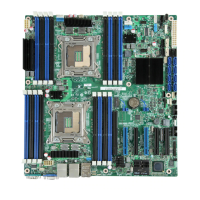Intel® Server Board S2600CP and Intel® Server System P4000CP Platform Management
Intel® Server Board S2600CP and Server System P4000CP TPS
Revision 1.1
Intel order number G26942-003
66
- [u,l][nr,c,nc] upper non-recoverable, upper critical, upper non-critical, lower non-
recoverable, lower critical, lower non-critical uc, lc upper critical, lower critical
Event triggers are supported event-generating offsets for discrete type sensors. The
offsets can be found in the Generic Event/Reading Type Code or Sensor Type Code
tables in the Intelligent Platform Management Interface Specification Second Generation
Version 2.0, depending on whether the sensor event/reading type is generic or a sensor-
specific response.
4. Assertion/Deassertion
Assertion and de-assertion indicators reveal the type of events this sensor generates:
- As: Assertion
- De: De-assertion
5. Readable Value/Offsets
- Readable value indicates the type of value returned for threshold and other non-
discrete type sensors.
- Readable offsets indicate the offsets for discrete sensors that are readable by means
of the Get Sensor Reading command. Unless otherwise indicated, event triggers are
readable. Readable offsets consist of the reading type offsets that do not generate
events.
6. Event Data
Event data is the data that is included in an event message generated by the associated
sensor. For threshold-based sensors, these abbreviations are used:
- R: Reading value
- T: Threshold value
7. Rearm Sensors
The rearm is a request for the event status for a sensor to be rechecked and updated
upon a transition between good and bad states. Rearming the sensors can be done
manually or automatically. This column indicates the type supported by the sensor. The
following abbreviations are used in the comment column to describe a sensor:
- A: Auto-rearm
- M: Manual rearm
- I: Rearm by init agent
8. Default Hysteresis
The hysteresis setting applies to all thresholds of the sensor. This column provides the
count of hysteresis for the sensor, which can be 1 or 2 (positive or negative hysteresis).
9. Criticality
Criticality is a classification of the severity and nature of the condition. It also controls the
behavior of the front panel status LED.
10. Standby
Some sensors operate on standby power. These sensors may be accessed and/or
generate events when the main (system) power is off, but AC power is present.

